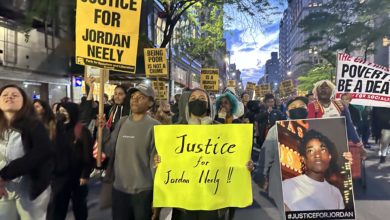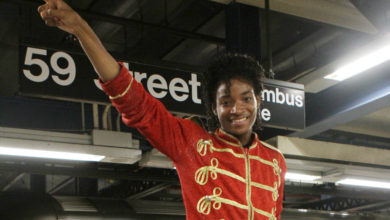The writer is a member of the National Coalition to Free the Angola 3. For more information on the Angola 3 or to get involved in the campaign to free them, visit www.angola3.org.
On Sept. 19, at 8 a.m. sharp, 25 longtime supporters of the Angola 3 assembled in St. Francisville, a sleepy southern
 |
The Angola prison is a former slave plantation named after the national origin of the slaves who were kidnapped and taken there. After the Civil War, it became a prison and operates on the plantation model to this day.
It is an 18,000-acre prison holding more than 5,000 prisoners. Over 75 percent of the prisoners are Black. Ninety-five percent of Angola’s prisoners have life sentences.
A two-and-a-half hour drive from New Orleans, it’s rather a remote and forbidding location for a public hearing.
The hearing was a long-awaited event for Herman Wallace, one of the Angola 3. The Angola 3 are three men who have been incarcerated for decades in the Louisiana State Penitentiary at Angola. All are former members of the Black Panther Party.
Herman Wallace and Albert Woodfox were falsely convicted of murdering a white prison guard in 1972, a time when Angola was a cauldron of racism and violence. It was known as the “bloodiest prison in America.”
The state has held Wallace and Woodfox in solitary confinement for over 34 years. They are still behind bars. Robert King Wilkerson, the third member of the group, was released in February 2001 after 29 years of solitary confinement.
Hearing at the prison
It is highly unusual to have evidentiary hearings at Angola prison. The court apparently was convinced that Wallace is a great security risk and could not be moved out of the confines of Angola prison.
But this was just another maneuver meant to punish Wallace, who is now 64-years-old. He has numerous health maladies, brought on not only by age but by the harsh conditions he has suffered over the past 34 years. There is nothing in his record that would indicate he was any type of security risk.
Wallace’s hearing took up the evidence that Hezekiah Brown, the only purported eyewitness to the murder for which Wallace was convicted, was provided a pardon, a transfer to minimum security, and other payment and favors in exchange for false testimony.
Supporters at the hearing included an internationally renowned businessman and philanthropist from England, a physician from Sacramento, a retired occupational therapist from Santa Rosa, a playwright from Massachusetts, two recently exonerated and released political prisoners, and at least 12 more people. There were grandmothers, students and people of every age in between.
When the supporters arrived at the prison, security was very heavy. The local sheriff’s officers at the entrance to the prison notified all that they would not be allowed inside the prison for the hearing, although they had previously been assured they could enter.
Several police cars sat in front of the prison watching over the scene. There were also SWAT team members in the
|
Clearly, the prison had wasted a ridiculously high amount of public funds on security for this hearing.
The Angola 3’s supporters then made a serious effort to negotiate with prison officials to ensure that Wallace’s two present family members would be allowed to witness the proceedings. After two hours, Wallace’s sister, Vicky, and his niece, Joanne, were escorted into the building where the hearing was taking place.
After the family members were admitted, the supporters waited outside the prison gates to learn the results of the hearing.
New trial possible
Hours later, at 3 p.m., the hearing ended. As reporters funneled out, lawyers Nick Trenticosta and Scott Fleming, and private investigator Susan Herrera shared the highlights of the hearing and told supporters just how well it had gone.
The evidence that Hezekiah Brown, the state’s key witness used to convict Wallace, had been given payment and favorable treatment to testify against Wallace made a huge impact on the court.
Trenticosta shared with supporters how inspired he was by Wallace and his courageous struggle, not only for his own freedom but for rights and relief for his fellow prisoners.
Supporters were thrilled to hear about new evidence indicating what they knew to be true—that Herman Wallace is an innocent man who was falsely convicted of a crime he did not commit.
Headlines like “Ex-Panther deserves new trial” in local papers the next day made Angola 3 supporters feel hopeful and vindicated. A new trial for Wallace, if granted, would come 34 years too late, but it would be a victory for Wallace, his supporters, and all who struggle against racism, injustice and oppression.
The court is expected to make a ruling in Wallace’s case in November.
When the lawyers had completed discussing the hearing’s results with supporters, an Indymedia reporter played a recording made by Prison Radio of an interview with Wallace from the night before. Wallace said, “I have my foot on the stairway to freedom and I’m so thankful that you all have come to share this moment with me.”







